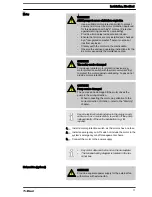
Check whether water is in the dosing head - if it would interfere.
Check whether the accessories supplied loose are correctly
assembled and installed. Use the operating instructions for the
loosely fitted accessories.
Check whether the safety equipment is correctly assembled and
working properly.
Check whether the entire electrical installation is correctly installed
and in accordance with local regulations. Also potential equalisa‐
tion and earthing lines.
Check whether the supply voltage from the drive motor,
actuator ...is correct.
Check whether the system is protected from overpressure.
Only in areas at risk from explosion: Set the opening pressure of
the (on site) relief valve downstream of the pressure manifold to a
maximum of 1.5 times the nominal pressure of the pump.
Check whether the suction line and discharge line are free from
tension and connected tightly.
Replace the closing screws on the oil filler neck with the vent
screws supplied.
Slight oil marks on the pump do not indicate leaks with
a new product.
Remove any oil stains and note their position.
Set the stroke length to start at 0 mm.
Check whether all obstacles have been removed in the suction and
discharge manifold and that the shut-off valves are open.
Check whether the actuator is working correctly over the entire
stroke length. This is also the case with drive units that are not
working.
Is the clamp of the stroke adjustment wheel working?
EF3a and EF4a only:
Check whether the scale bushing with the round scale is correctly
fitted.
Checking for water
Checking for accessories supplied
loose
Checking the safety equipment
Checking the electrical installation
Checking the supply voltage
Adjusting the relief valve (on site)
Checking the suction line and dis‐
charge line
Installing the vent screws with filter
Setting the stroke length to 0 mm
Checking the flow in discharge and
suction lines
Checking the stroke length adjust‐
ment
Checking the scale bushing
Start Up and Operation
23










































